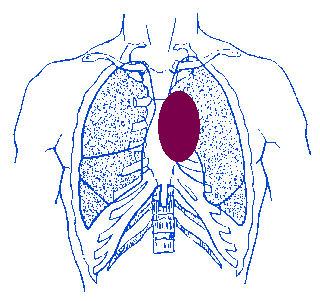Cancer Radiother 1997;1(2):137-42 Postoperative
radiotherapy in non-small cell lung cancer. Apropos of a series of 374 cases.
Baillet.Several randomized trials have led us to address the usefulness of post-surgical
external beam therapy (EBT) in non-oat cell bronchial carcinoma. Regarding the benefits of
post-surgical radiotherapy, the analysis of the six randomized trials does not allow any
conclusion. This might be due to either the insufficient number of cases, a follow-up time
not long enough, incorrect radiotherapy, or insufficient available data. Comparison of the
results pertaining to the six trials with those of our series shows an advantage for the
current series, indicating that survival is likely to be improved if
EBT is correctly done with regard to the dose, volume and technique used.
Int J Radiat Oncol Biol Phys 1982 Nov;8(11):1877-80
Evaluation of adjuvant postoperative radiotherapy for lung
cancer.
Chung. One hundred eighteen patients with lung cancer were retrospectively analyzed to
determine whether postoperative radiotherapy (RT) improves survival. Postoperative RT
reduced local recurrence and improved 3 year survival among patients with positive nodes.
However, postoperative RT did not improve survival among those with negative nodes. Our
data indicated that patients with positive hilar or mediastinal
nodes may require postoperative RT to improve survival.
Radiology 1975 Aug;116(02):405-7
Postresection irradiation for primary lung cancer.
Green N, Kurohara SS, George FW 3rd, Crews QE Jr
A total of 219 patients with proved lung cancer were studied to determine whether
postresection irradiation improves survival. The results showed that postresection
irradiation improved survival among patients with hilar and mediastinal lymph-node
metastases of all histological types but did not improve survival among patients without
node metastases. The authors recommend that patients with resectable
lung cancer involving the hilar and mediastinal lymph nodes be treated by a combination of
surgery and radiotherapy.
Lancet 1998 Jul 25;352(9124):257-63
Postoperative radiotherapy in non-small-cell lung cancer:
systematic review and meta-analysis of individual patient data from nine randomised
controlled trials. PORT Meta-analysis Trialists Group.
The results show a significant adverse effect of postoperative
radiotherapy on survival (hazard ratio 1.21 [95% CI 1.08-1.34]). This 21% relative
increase in the risk of death is equivalent to an absolute detriment of 7% (3-11) at 2
years, reducing overall survival from 55% to 48%. Subgroup analyses suggest that this
adverse effect was greatest for patients with stage I/II, N0-N1 disease, whereas for those
with stage III, N2 disease there was no clear evidence of an adverse effect.
INTERPRETATION: Postoperative radiotherapy is detrimental to patients with early-stage
completely resected NSCLC and should not be used routinely for such patients. The role of postoperative radiotherapy in the treatment of N2 tumours is
not clear and may warrant further research.
Cancer Prev Control 1997 Dec;1(5):366-78
Adjuvant radiotherapy and chemotherapy for stage II or IIIA
non-small-cell lung cancer after complete resection. Provincial Lung Cancer Disease Site
Group.
Logan There was no survival benefit with adjuvant radiotherapy alone, although 3 RCTs
reported a reduction in the rate of local recurrence among patients treated with adjuvant
radiotherapy. There is evidence from RCTs that postoperative
radiotherapy reduces rates of local recurrence by 11% to 18% (or 1.6 to 19-fold)
among patients with completely resected, pathologically confirmed stage II or IIIA NSCLC.
Therefore, if the outcome of interest is a reduction in the frequency of local tumour
recurrence, radiotherapy is recommended. However, there is no
evidence of a survival benefit from postoperative radiotherapy alone.
N Engl J Med 1986 Nov 27;315(22):1377-81
Effects of postoperative mediastinal radiation on completely
resected stage II and stage III epidermoid cancer of the lung. The Lung Cancer Study
Group.
We randomly assigned 230 patients with resected Stage II or III epidermoid
(squamous-cell) lung cancer to receive postoperative adjuvant radiotherapy or no adjuvant
treatment. There was no evidence that radiotherapy improved
survival, and although recurrence rates appeared to be somewhat reduced among
patients assigned to radiotherapy, these decreases were not statistically significant.
However, radiotherapy did produce a striking and significant reduction in recurrences to
the ipsilateral lung and mediastinum. Moreover, overall recurrence rates were reduced by
radiotherapy in patients with N2 disease (P less than 0.05), although even this subgroup
had no evidence of improved survival.
Eur J Cardiothorac Surg 1996;10(11):947-50; discussion 951
"Adjuvant" external radiation of the mediastinum in
radically resected non-small cell lung cancer.
Smolle-Juettner. The effect of postoperative external beam radiation in MO non-small
cell lung cancer resected with curative intention was evaluated in a randomized trial.
group A (72 patients) had no further oncologic treatment, while group B (83 patients) had
external beam radiation to the mediastinum (50-56 Gy, 8 or 23 MeV photons, 2 Gy/day, 5
days a week) beginning 4 weeks after the operation. External
radiation of the mediastinum in radically resected non-small cell lung cancer reduces the
risk of local recurrence, but has no influence on distant metastastic spread and overall
survival.
Br J Cancer 1996 Aug;74(4):632-9
The role of post-operative radiotherapy in non-small-cell lung
cancer: a multicentre randomised trial in patients with pathologically staged T1-2, N1-2,
M0 disease. Medical Research Council Lung Cancer Working Party.
Stephens. The role of post-operative radiotherapy for patients with non-small-cell lung
cancer (NSCLC) is unclear despite five previous randomised trials. One deficiency with
these trials was that they did not include adequate TNM staging, and so the present
randomised trial was designed to compare surgery alone (S) with surgery plus
post-operative radiotherapy (SR) in patients with pathologically staged T1-2, N1-2. M0
NSCLC. Overall there was no advantage to either group in terms of
survival, although definite local recurrence and bony metastases appeared less frequently
and later in the SR group. In a subgroup analysis, in the N1 group no differences
between the treatment groups were seen, but in the N2 group SR
patients appeared to gain a one month survival advantage, delayed time to local
recurrence and time to appearance of the bone metastases. There is, therefore, no clear
indication for post-operative radiotherapy in N1 disease, but the question remains
unresolved in N2 disease. |
